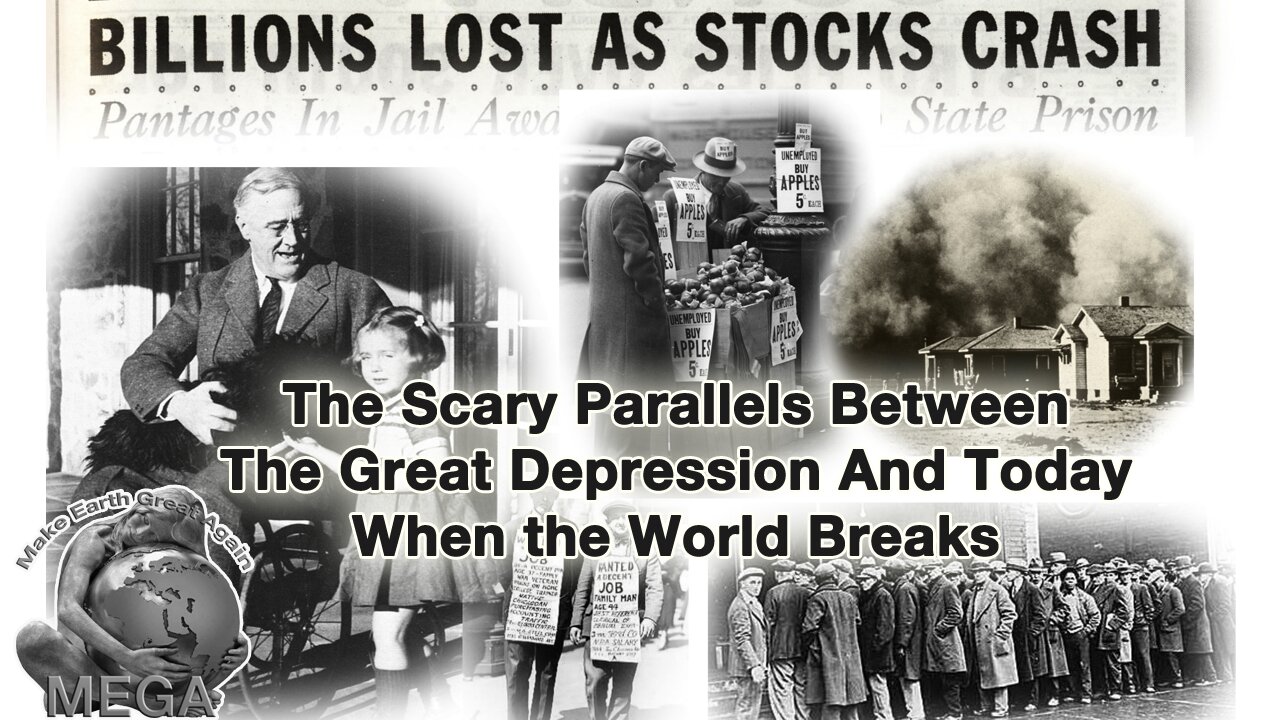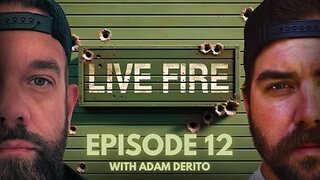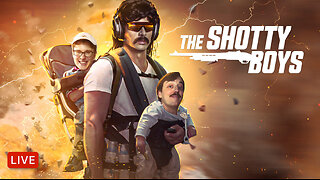Premium Only Content

The Scary Parallels Between The Great Depression And Today | When the World Breaks
History holds many lessons. Looking back, it’s pretty alarming to note the striking parallels between the Great Depression of the 1930s and today’s economic climate. Echoes from the past seem to be resounding louder than ever.
Many people will point to the differences between 2023 versus the Great Depression. Still, they may not remember the roaring 1920s came before the Great Depression, and the 1929 end game of that era has a lot of similarities with 2023. There are many parallels between today’s world and the one that gave us the Great Depression. Let’s dive into the details.
Stock Market Volatility
Much like the infamous Wall Street Crash of 1929, today’s stock market is showing signs of turbulence. In the late 1920s and early 1930s, stocks swung wildly before plummeting, ushering in the Great Depression. Today, traders are on edge as the market bobs and weaves, reflecting an unsettling instability. While some indices and stocks may be near all-time highs, others have been in an extensive trading range for two years. We may already be in a cyclical sideways market with the danger of a bear market or even a crash.
Speculation
In the late twenties, speculation ran rampant, with countless investors putting their money into the stock market, hoping for quick and easy returns. Stock prices soared, driven more by this rampant speculation than by the companies’ actual value. There was a frenzy in the air, a belief that the upward trajectory was never-ending.
Fast forward to the 2020s, and the scene feels eerily similar. Swap out the stock market for modern equivalents like cryptocurrencies, SPACs, NFTs, and the previous red-hot real estate market. Cryptocurrencies, in particular, have drawn massive speculation, their volatile prices often driven by investor sentiment rather than any intrinsic value.
Ezoic
SPACs, or particular purpose acquisition companies, have also emerged as popular speculative investments. They’re often called “blank check” companies, raising funds to acquire a private company and take it public. But there’s risk involved, as investors essentially place their trust (and money) in the SPAC’s management without knowing what company they’ll eventually acquire. Many SPACs have already collapsed in value.
The real estate market isn’t immune to speculation either. With historically low interest rates, many investors were buying properties hoping to sell them at a profit or renting them out. There was a sense of urgency, a belief that now was the time to invest in 2021 and 2022, driving prices up and creating housing market conditions that seemed to teeter on the precipice. With the raising of interest rates by the Federal Reserve, the buying frenzy in real estate has ended, and houses are moving more slowly, with many real estate markets seeing price reductions to sell houses at all.
In both eras, the spirit of speculation has shown its ability to overheat markets, creating precarious bubbles destined to burst if history is any guide. As we’ve seen, the consequences can be devastating, making this parallel one of the most worrisome.
High Levels Of Economic Inequality
The chasm between the haves and the have-nots today is reminiscent of the 1930s. Wealth concentrated at the top while most struggled to make ends meet. You can see a mirror of that scenario in today’s economy.
Increased Homelessness
During the Depression, homelessness spiked as people lost their jobs and couldn’t pay rent. You can’t help but notice the growing number of individuals living on the streets today in many major cities with nowhere to live. Many cities have homeless encampments very similar to the great depression. The similarity is haunting.
“Hooverville” became a common term for shacktowns and homeless encampments during the Great Depression. There were dozens in the state of Washington and hundreds throughout the country, each testifying to the housing crisis that accompanied the employment crisis of the early 1930s.[1]
Widespread Business Failures
Scores of businesses shut their doors during the Great Depression. Fast forward to today, and you’ll see many “closed” signs in storefront windows. Mom-and-pop stores, well-established businesses—it’s a broad spectrum of devastation.
An estimated 17,145 retail stores in the United Kingdom closed throughout 2022. This is a dramatic increase from 2021, during which 11,459 stores closed.
Bank Failures And Financial System Instability
In the 1930s, bank failures shook the public’s confidence in the financial system. Similarly, today, there’s unease about the robustness of financial institutions, especially in light of recent crises.
The three banks that failed this year — Silicon Valley Bank (SVB), First Republic Bank (FRB), and Signature Bank — accounted for 2.4% of all assets in the banking sector. [3]
Global Economic Slowdown
The Depression wasn’t confined to the U.S. It spread globally, causing widespread despair. Today, we’re facing a worldwide slowdown too. Economies across the globe are in a tight spot, adding a universal dimension to the struggle: Europe, China, and the U.S. all have slowing economies as their overall trend.
Trade War Tensions
Trade wars were a feature of the Depression era. Similarly, rising trade tensions define our global economic scenario today, straining relationships between nations. Worldwide trade sanctions exist between Russia and the West, along with a U.S. and China trade war that has been escalating.
Declining Consumer Confidence
When times get tough, people tighten their belts. They did it during the Depression, and they’re doing it today. Many consumers have been trading down to cheaper alternatives in food and entertainment.
Rising National Debt
The Depression-era saw the national debt rise as the government borrowed heavily. Our national debt is skyrocketing today, sparking concerns about the financial future.
Tightening Of Credit Markets
Back then, banks became cautious and tightened their lending criteria. Credit markets follow a similar trend today, making it harder for businesses and individuals to secure loans.
Escalating Political And Social Unrest
A suffering economy and political turbulence often go hand in hand. The Great Depression saw its share of upheaval, and the current economic hardships are stirring a similar pot of unrest and a divisive political environment worldwide in many countries.
-
 4:23:49
4:23:49
FreshandFit
12 hours agoIsrael v Palestine Debate! Respect A Man If He Says No Or Yes To A Girl's Trip?
165K176 -
 2:05:33
2:05:33
TheSaltyCracker
14 hours agoTech Bros try to Hijack MAGA ReeEEeE Stream 12-27-24
298K511 -
 2:01:25
2:01:25
Roseanne Barr
19 hours ago $41.26 earnedJeff Dye | The Roseanne Barr Podcast #80
134K67 -
 7:32
7:32
CoachTY
17 hours ago $12.19 earnedWHALES ARE BUYING AND RETAIL IS SELLING. THIS IS WHY PEOPLE STAY BROKE!!!
124K8 -
 1:01:00
1:01:00
Talk Nerdy 2 Us
14 hours ago💻 From ransomware to global regulations, the digital battlefield is heating up!
44.4K2 -
 3:00:24
3:00:24
I_Came_With_Fire_Podcast
16 hours agoHalf the Gov. goes MISSING, Trump day 1 Plans, IC finally tells the Truth, Jesus was NOT Palestinian
92.4K38 -
 4:11:49
4:11:49
Nerdrotic
19 hours ago $42.87 earnedThe Best and Worst of 2024! Sony Blames Fans | Batman DELAYED | Nosferatu! |Friday Night Tights 334
209K40 -
 7:55:51
7:55:51
Dr Disrespect
22 hours ago🔴LIVE - DR DISRESPECT - WARZONE - SHOTTY BOYS ATTACK
250K33 -
 1:30:23
1:30:23
Twins Pod
22 hours agoHe Went From MARCHING With BLM To Shaking Hands With TRUMP! | Twins Pod - Episode 45 - Amir Odom
158K34 -
 1:02:30
1:02:30
Exploring With Nug
23 hours ago $4.84 earned2 Duck Hunters Missing After Kayak Capsizes!
78.6K6